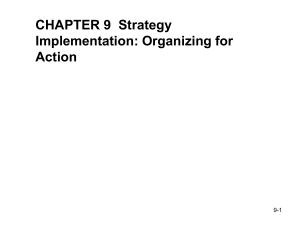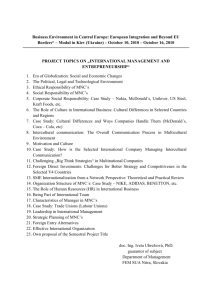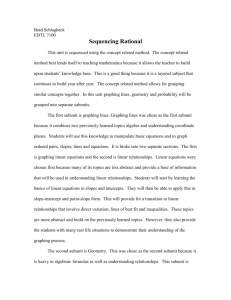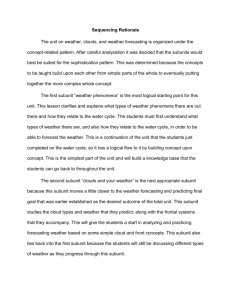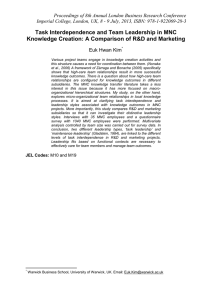Proceedings of 5th Asia-Pacific Business Research Conference
advertisement
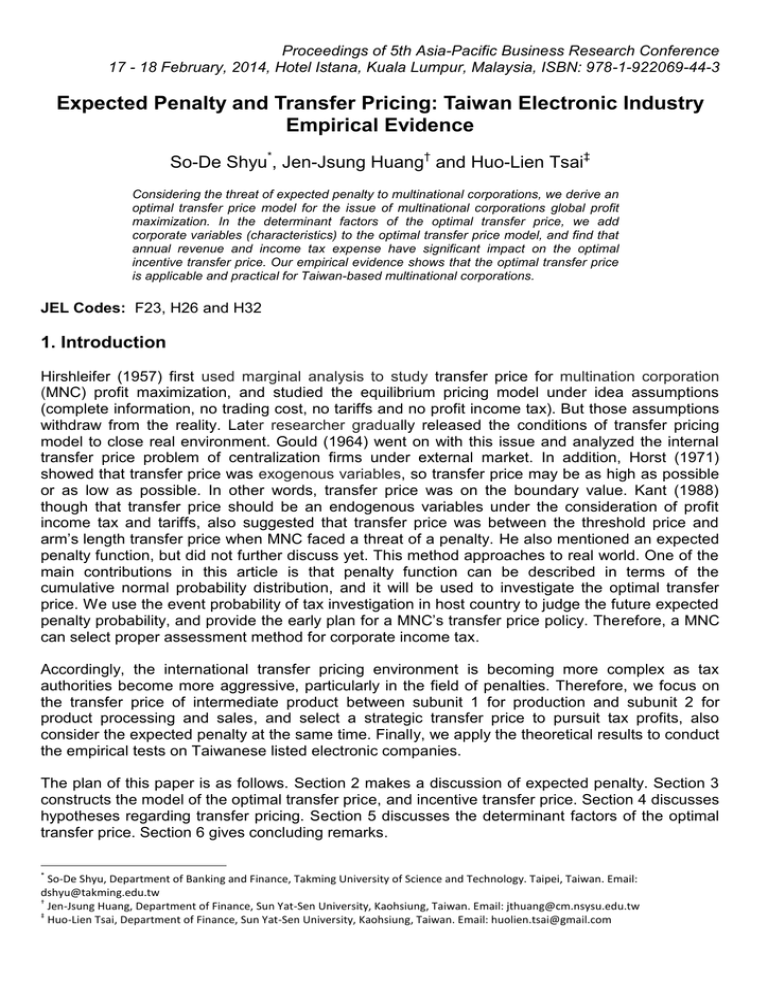
Proceedings of 5th Asia-Pacific Business Research Conference 17 - 18 February, 2014, Hotel Istana, Kuala Lumpur, Malaysia, ISBN: 978-1-922069-44-3 Expected Penalty and Transfer Pricing: Taiwan Electronic Industry Empirical Evidence So-De Shyu*, Jen-Jsung Huang† and Huo-Lien Tsai‡ Considering the threat of expected penalty to multinational corporations, we derive an optimal transfer price model for the issue of multinational corporations global profit maximization. In the determinant factors of the optimal transfer price, we add corporate variables (characteristics) to the optimal transfer price model, and find that annual revenue and income tax expense have significant impact on the optimal incentive transfer price. Our empirical evidence shows that the optimal transfer price is applicable and practical for Taiwan-based multinational corporations. JEL Codes: F23, H26 and H32 1. Introduction Hirshleifer (1957) first used marginal analysis to study transfer price for multination corporation (MNC) profit maximization, and studied the equilibrium pricing model under idea assumptions (complete information, no trading cost, no tariffs and no profit income tax). But those assumptions withdraw from the reality. Later researcher gradually released the conditions of transfer pricing model to close real environment. Gould (1964) went on with this issue and analyzed the internal transfer price problem of centralization firms under external market. In addition, Horst (1971) showed that transfer price was exogenous variables, so transfer price may be as high as possible or as low as possible. In other words, transfer price was on the boundary value. Kant (1988) though that transfer price should be an endogenous variables under the consideration of profit income tax and tariffs, also suggested that transfer price was between the threshold price and arm’s length transfer price when MNC faced a threat of a penalty. He also mentioned an expected penalty function, but did not further discuss yet. This method approaches to real world. One of the main contributions in this article is that penalty function can be described in terms of the cumulative normal probability distribution, and it will be used to investigate the optimal transfer price. We use the event probability of tax investigation in host country to judge the future expected penalty probability, and provide the early plan for a MNC’s transfer price policy. Therefore, a MNC can select proper assessment method for corporate income tax. Accordingly, the international transfer pricing environment is becoming more complex as tax authorities become more aggressive, particularly in the field of penalties. Therefore, we focus on the transfer price of intermediate product between subunit 1 for production and subunit 2 for product processing and sales, and select a strategic transfer price to pursuit tax profits, also consider the expected penalty at the same time. Finally, we apply the theoretical results to conduct the empirical tests on Taiwanese listed electronic companies. The plan of this paper is as follows. Section 2 makes a discussion of expected penalty. Section 3 constructs the model of the optimal transfer price, and incentive transfer price. Section 4 discusses hypotheses regarding transfer pricing. Section 5 discusses the determinant factors of the optimal transfer price. Section 6 gives concluding remarks. * So-De Shyu, Department of Banking and Finance, Takming University of Science and Technology. Taipei, Taiwan. Email: dshyu@takming.edu.tw † Jen-Jsung Huang, Department of Finance, Sun Yat-Sen University, Kaohsiung, Taiwan. Email: jthuang@cm.nsysu.edu.tw ‡ Huo-Lien Tsai, Department of Finance, Sun Yat-Sen University, Kaohsiung, Taiwan. Email: huolien.tsai@gmail.com Proceedings of 5th Asia-Pacific Business Research Conference 17 - 18 February, 2014, Hotel Istana, Kuala Lumpur, Malaysia, ISBN: 978-1-922069-44-3 2. Expected penalty The tax authority audits transfer price data and does not investigate if the report transfer price is located on inside the range of 25% to 75%, but the tax authority will investigate the report transfer price when it is located on outside the range of 25% to 75%. We can use empirical penalty accumulation distribution function to judge a MNC’s transfer price is located on which point of probability function (wˆ w) and associated with relative reference data to judge that it need to investigate or not. Kant (1988) assumed that penalty is driven by a certainly percent ( q ) of exceed arm’s length price, thus the transfer price penalty is equal to probability multiply expected penalty, that is [ 2 (wˆ w)m] . Therefore, we can obtain the following result: expected penalty Ψ is positive when > 0 and (wˆ w) qw ; and expected penalty Ψ is zero when = 0 or (wˆ w) qw . Assuming the transfer pricing evaluation by tax authority does not change, but its attitude changes. The tax authority attitude tends to strictly follow the tax laws. In other words, more supervise management works and wider investigation is executed. These two factors will enhance tax investigation strength. Therefore, the probability density function can be expressed as ( g,(wˆ w)) , where g is transfer parameter (Kant, 1988). A MNC moves its transfer price toward the arm's length price, but the transfer quantity will change in opposite direction. Therefore, the problem of Prisoner's Dilemma is that the tax authority’s supervise management tends to strictly follow tax laws. This behavior will also generate capital shift outside and reduce the labor quantity. In contrast, the behavior of tax administrator will reduce income taxation when countries with more relaxed tax policies. MNC use different accounting systems for tax and managerial purposes. Moreover, we discuss the optimal incentive transfer price and the optimal tax transfer price between oversea subunit 1 and subunit 2. We make single side trading assumption, each oversea subunit has revenue function ( Ri ( pi , xi ) ), where p i is import (or export) price and x i is net import (or export) quantity, and satisfies Ri' ( pi , xi ) 0 and Ri" ( pi , xi ) 0 , at the same time, profit function ( i ) is a concave function for every subunit. We also assume that a MNC has two oversea subunits. Every oversea subunit belongs to different country. The tax authority uses transfer pricing model ( Hirshleifer, 1957) to calculate a arm’s length price, and sets up a receivable range 0 w wˆ w , where ŵ is theory transfer price. We discuss the MNC global profit maximum problem, and do analysis as follows: Our mainly object is to consider both incentive transfer price ( s ) and tax transfer price ( t ) to use tax transfer price to gain tax deduction. Unpaid amounts are X 2 (wˆ w)m and MNC will be punished when tax arbitrage is detected. First, Expected penalty ( 2 (wˆ w)m) is assumed to be a smooth convex function, and satisfies the following conditions: (0) lim '(X) 0 , '(X) 0 and X 0 (X) 0 . In addition, MNC profit function is as follows: max(1 1 )[ R ( p , x) wx ˆ r1 x] (1 2 )[ R2 ( p 2 , x) r2 x wx ˆ ], 1 1 x,w where transfer quantity x 0 (or m 0 ) and ad-valorem tax r1 , r2 0 and w wˆ w , so rewrite the MNC ˆ [(1 2 )r2 (1 1 )r1 ]x . Then, we profit function as follows: max[(1 1 ) R1 ( p1, x) (1 2 ) R2 ( p2 , x)] ( 2 1 )wx x,w discuss that MNC faced two scenarios under two oversea subunits, external market and nonexternal market. Moreover, discuss steady analysis between subunit 1 and subunit 2. When r1 r2 0 , global profit function can be written: max(1 1 ) R1 ( p1, x) (1 2 ) R2 ( p2 , x) ( 2 1 )wx ˆ , where x 0. x,w _ We attempt to obtain w to maximize MNC profit when 2 1 , and obtain w to maximize MNC profit when 2 1 , and transfer price will not affect MNC profit when 2 1 . Proceedings of 5th Asia-Pacific Business Research Conference 17 - 18 February, 2014, Hotel Istana, Kuala Lumpur, Malaysia, ISBN: 978-1-922069-44-3 3. Model of the optimal tax transfer price and incentive transfer price The optimal incentive transfer price was on comparable condition and also did not take into accounts import tariff. Therefore, we try to derive a more general model including both tax rate and tariff. Assuming a MNC is forced ad-valorem tax r1 (or r2 ) and imports (exports) goods tariff amounts mwr ˆ 1 (or mwr ˆ 2 ) in internal tangible product transfer. We also assume that the transfer intermediate product quantity ( m ) of subunit 1 to subunit 2 is under single trading. In addition, the cost function of subunit 1 is represented by C1 ( p1 , m) . The revenue function of subunit 2 is R2 ( p 2 , m) . Moreover, the manufacture cost ( C ( p, m) ) is equal to unit cost multiply transfer quantity, where unit cost is a constant. Furthermore, the tax rate of subunit 2, 2 , is higher than the tax rate of subunit 1, 1 , and the export tariff duties of subunit 1 is r1 and the import tariff duties of subunit 2 is r2 . For the convenience of deriving the optimal incentive transfer price and the optimal tax transfer price, we replace theoretical transfer price ŵ with tax transfer price ( t ). The incentive transfer price ( s ) is real intermediate product transfer price in derived processes. First, we assume that the subunit manager has the right to decide transfer quantity of intermediate product import. Then the profit function of subunit 1 can be expressed by 1 (1 1 )[wx ˆ 1 C1 ( p1 , x1 ) r1 x1 ] , where x1 m and the profit function of subunit 2 is: 2 (1 2 )[R 2 ( p2 , x2 ) r2 x2 wx ˆ 2] , where x2 m . Then each affiliate’s objective becomes: ˆ 1 C1 ( p1 , x1 ) r1x1 ] c1 m sm 1 ( c1m tm) (1 1 ) r1m (1 1 )( c1m r1m) sm 1tm 1 (1 1 )[wx and ˆ 2 ] (1 2 ) R2 (m) m 2tm (1 2 )r2 m [ 2 (t m)m] 2 (1 2 )[R 2 ( p2 , x2 ) r2 x2 wx (1 t2 )[ R2 (m) r2 m] (s 2t )m [ 2 (t w)m] . is: The objective for the MNE as a whole T (1 2 )( R2 (m) r2 m) (s 2t )m [ 2 (t w)m] (1 1 )(c1 m r1m) sm 1tm (1 2 )( R2 (m) r2 m) [ 2 (t w)m] (1 1 )(c1m r1m) ( 2 1 )tm We do both of partial derivative of the total profits function T with respect to the variable m and partial derivative of the profit function 2 with respect to the variable m , respectively, also let two partial derivatives are equal. Finally, we gain the optimal incentive transfer price as follows: (1) S 1t (1 ) 2 (t w)[ 2 (t w)m] (1 1 )(c1 r1 ) . where c is subunit unit cost, and 1 and 2 are income tax rate for subunit 1 and subunit 2, respectively. We do a comparison between Choe and Hyde (2007) and above equation (1), there are the same result as Choe and Hyde (2007) when r1 r2 0 , in another word , the difference is tariff between both. S price is the weight average of arm’s length transfer price and subunit 1 unit cost and its tariff and plus the expected penalty adjustment item. For expected penalty analysis, we find that transfer price difference t w will affect compensation items. The partial derivative of total profits with respect to the variable t is: T 2 m[ 2 (t w)m] ( 2 1 )m 0 . Let t T , and get t the optimal tax transfer price T: T w 1 1 (1 1 ) 2m 2 (2) where 1 and 2 are income tax rate for subunit 1 and subunit 2, respectively. Finally, expected penalty depends on price difference, t w . Due to t is selected by MNC and transfer quantity ( m ) is decided by subunit 2. Therefore, if there is no tax penalty in high tax country, then high-tax subunit manager should increase transfer quantity to reach the optimal level. Proceedings of 5th Asia-Pacific Business Research Conference 17 - 18 February, 2014, Hotel Istana, Kuala Lumpur, Malaysia, ISBN: 978-1-922069-44-3 4. Hypotheses Regarding Transfer Pricing The OECD statistical data from 2003 to 2010 indicated that 40% Taiwanese electronic commodities exported to west EURO and United States. Many Taiwanese electronic companies receipted the order of international company. When a Taiwan-based MNC receives U.S. customer’s order, the MNC exports raw material to Mainland China subunit, then buys complete products and again sells to U.S. customers, so-called “Mainland China export, Taiwan negotiation”. The research data come from the Taiwan Economic Journal (TEJ) database and the website of the Taiwan Stock Exchange (TWSE). It includes 335 TWSE-listed and OTC-listed electronic companies in 2003. Due to intermediate product transfer, we need listed firms to have both oversea Mainland China subunit and U.S. subunit in sample period. Our sample selection criteria require listed firms to have complete financial data and intermediate products for local reprocessing data from TEJ during the sampling period. Therefore, we exclude any other listed firms by non-intermediate products for local re-processing such as telecommunication equipment companies and semiconductor companies. Non-manufacturers (i.e. information service firms, channel firms, IC design firms) are also excluded. Overall, this study is based on firms publicly listed in the TWSE, but the sample observations exclude remaining restrictions on intermediate products for local re-processing. This selection process results for 37 firms in 2003 - 2010. Table 1 provides descriptive statistics for intermediate products transfer price and unit price. Overall, four variables on both average value and standard deviation have the highest value in 2003, and decreasing in period 2004 to 2008, but has a little raise on both average value and standard deviation in 2010. The trend are consistent as expected because multinationals transfer price document report since May 2005 and financial crisis was happen in July 2008. Proceedings of 5th Asia-Pacific Business Research Conference 17 - 18 February, 2014, Hotel Istana, Kuala Lumpur, Malaysia, ISBN: 978-1-922069-44-3 TABLE I: SUMMARY STATISTICS This table presents the summary statistics for the main variables used in the empirical analysis. The sample period was from 2003 to 2010. In panel A, normal trading price (unit price, external market trading price) is equal to annual sales amounts divide by annual sale quantity. Intermediate product transfer price ŵ is equal to the sum of intermediate product unit various cost and other products unit marginal contribution, as negotiated price. In panel B, S price, optimal incentive transfer price, is the weight average of marginal cost and the optimal tax transfer price, plus regulation item coming from the compensation of expected penalty. T price, optimal tax transfer price, is consists of arm’s length transfer price and the compensation of tax difference between the two subunits. STD stands for standard deviation. Panel A unit price theory transfer price Year average minimum maximum STD average minimum maximum STD 2003 5.27 50986.20 5.78 54253.62 11550.86 10.31 38510.06 11112.25 9337.91 6698.66 2004 6301.64 5732.84 6042.49 10.54 41060.89 9669.86 2005 4959.92 31981.16 7900.56 5196.47 10.81 33589.45 8149.97 2006 21659.04 6296.47 4482.94 12.51 21659.04 6606.78 2007 4201.91 4395.65 9.86 10.59 11.25 13.48 21717.79 6762.06 4250.44 11.18 6615.07 6139.26 4575.06 2008 21631.96 20251.93 4456.54 11.09 20251.93 6258.44 2009 4959.59 10.48 19452.86 6405.72 5175.06 15.61 19452.86 6588.39 2010 5146.97 10.35 31143.49 7202.66 5384.61 12.16 31143.49 7428.99 Panel B S price T price Year average minimum maximum STD average minimum maximum STD 2003 5.15 39516.12 10.31 38512.35 11113.10 9338.65 2005 4295.88 7.58 7.94 6303.08 5734.04 50994.62 31337.07 9199.91 8352.71 5.27 2004 5331.60 5099.75 23819.98 6599.96 4960.03 31981.16 7900.51 2006 3798.35 8.04 20881.33 5706.63 21659.04 6296.37 2007 4226.99 29346.96 6813.04 11.24 21631.96 2008 3791.70 8.17 8.45 4202.33 4395.65 9.86 10.59 19306.24 5512.89 4252.59 20251.93 2009 4344.11 7.47 18067.89 5784.16 4960.01 11.18 10.47 6615.07 6138.74 19452.86 6405.60 2010 4443.60 7.91 23849.60 6257.21 5148.50 10.35 31143.35 7201.90 We want to know what happen in sample period and do empirical analysis. First, we discuss the expected penalty function, and assume that the affiliates are fully owned. For the convenience of transfer quantity calculation, this study assumes that OEM quantity for each OEM order is known because the MNC has an excellent manufacture technology and does not exit trade negotiations volume. The treatment of expected penalty function, [ 2 (t w)m] , will be explained below. We assume that each nation’s income tax rate and transfer quantity are given, so penalty function can be rewritten as 2 m[(t w)] 2m[( x)] , where random variable is x t w . Its standardization form is Z ( x uX ) / X . Hence, accumulation distribution function form can be expressed as 2 m[ Z ] , and [ Z ] is density function. Therefore, empirical accumulation distribution function ( x) and its probability function ( x) can be yielded by means of history data. In addition, due to statistic software development, we can calculate empirical probability function (t w) and its inverse function, 1 (t w) , where normal trading price ( w ) is given although external market trading price is different in every year. We do Kolmogorov-Smirnov test and Shapiro-Wilk normality test, and all statistic values are high significance in 2003 - 2010 in Table 2. In addition, the diagram of ŵ w Proceedings of 5th Asia-Pacific Business Research Conference 17 - 18 February, 2014, Hotel Istana, Kuala Lumpur, Malaysia, ISBN: 978-1-922069-44-3 sample probability density function is shown in appendix A. Therefore, the results show that theory spread tdp = ŵ w is a normal distribution. TABLE 2: NORMALITY TEST OF THEORY SPREAD VARIABLE Intermediate product transfer price ŵ is equal to the sum of intermediate product unit various cost and other products unit marginal contribution, as negotiated price. Normal trading price (external market trading price) is equal to annual sales amounts divided by sales quantity. Ho: The distribution of data is normal. Note: d.f. is degree of freedom, sig. is level of significance. Levels of significance are indicated by *, **, and *** for 5%, 1%, and 0.1% respectively. Kolmogorov-Smirnov test Shapiro-Wilk normality test variable Test value d.f. sig. Test value d.f. sig. tdp2003 0.393 37 0.000*** 0.454 37 0.000*** tdp2004 0.432 37 0.000*** 0.405 37 0.000*** tdp2005 0.383 37 0.000*** 0.340 37 0.000*** tdp2006 0.464 37 0.000*** 0.309 37 0.000*** tdp2007 0.426 37 0.000*** 0.226 37 0.000*** tdp2008 0.423 37 0.000*** 0.310 37 0.000*** tdp2009 0.380 37 0.000*** 0.299 37 0.000*** tdp2010 0.423 37 0.000*** 0.228 37 0.000*** Based on above discussion of intermediate product transfer price between subunit 1and subunit 2, we replace theory transfer price ŵ with tax transfer price ( T ), and incentive transfer price ( S ) is real intermediate product transfer price. The tax transfer price, T w [1/ ( 2 m* )] 1[1 (1 / 2 )] , will be larger than unit price. Because the probability density function can be expressed as [ g ,(wˆ w)] , where g is transfer parameter (Kant, 1988). So we set theory spread that is equal to theory negotiated price minus unit price, that is ŵ w . Intermediate product transfer price ŵ is equal to the sum of intermediate product unit various cost and other products unit marginal contribution, as negotiated price. Table 3 indicates that the average values of theoretical spread gradually decrease from 2003 to 2007, but have a little promotion in 2010. In addition, Table 3 also reports the spread (dp) description statistics. Here, spread was equal to optimal incentive transfer price minus unit price. The result shows that there was sharp reduction from 2003 to 2004 in the average value of spread. Taiwan-based MNC have started to report annual transfer price document since May 2005. There was significant absolute average value reduction from 2004 to 2007, but have a little promotion in 2010. Recently, each country pays more attention to transfer pricing taxation. Hence, the transfer pricing policy of intermediate product for MNC tends to unity. Furthermore, information and communications technology products face keen competition in international market and sale prices continue to fall in recent years. Therefore, the profit of original equipment manufacturer has been relative reduction. Proceedings of 5th Asia-Pacific Business Research Conference 17 - 18 February, 2014, Hotel Istana, Kuala Lumpur, Malaysia, ISBN: 978-1-922069-44-3 TABLE 3: DESCRIPTION STATISTICS OF THEORY SPREAD AND SPREAD S 1t (1 ) 2 (t w)[ 2 (t w)m] (1 1 )(c1 r1 ) is incentive transfer price, where w is normal trading price, m is OEM intermediate product transfer quantity, is penalty probability, c is intermediate product unit cost, is expected penalty, ŵ is intermediate product transfer price, t is optimal tax transfer price, 2 is U.S. subunit 2 operation tax rate, 1 is Mainland China subunit 1 operation tax rate. Spread is s w . Theory spread is ŵ w . theory spread (tdp) spread (dp) variable average minimum maximum average minimum maximum 2003 397.02 -238.28 4577.30 -970.04 -11470.08 1786.17 2004 322.51 -57.47 4412.39 -633.10 -7172.99 297.97 2005 230.39 -436.28 5071.02 -664.04 -8989.07 1557.80 2006 261.42 -374.92 5627.03 -403.56 -3868.17 3109.45 2007 180.10 -354.08 5555.85 -168.66 -4506.27 7714.99 2008 196.13 -388.78 4735.72 -458.74 -3010.56 963.85 2009 207.95 -405.69 5366.05 -615.48 -3944.92 849.37 2010 235.42 -410.35 7266.89 -703.37 -7293.88 345.99 We discuss the comparison relation between transfer price and unit price. Due to information and communications technology products face keen competition, intermediate product prices continue to fall. The theory spread ŵ w sometimes positive or negative, hence, the value of X 2 (wˆ w)m sometimes positive or negative. In this section, we conduct hypothesis test to check the above relationship in S price and T price. 1). The optimal incentive transfer price Because the practical difference is small between theory transfer price and unit price, we assume that δ function value is 0, so S 1t 2 (t w)[ 2 (t w)m] (1 1 )(c1 r1 ) . Due to 2 1 , MNC will raise transfer price and transfer intermediate product from subunit 1 with low tax to subunit 2 with high tax. Therefore, the following assumption can be established: a MNC raises transfer price and transfer intermediate product from low tax subunit to high tax subunit, high-tax subunit manager should increase expected penalty compensation S 2 . Therefore, S price should be lower than unit price. The first hypothesis can be expressed as follows: Hypothesis 1: 1 : S price unit price 1 : S price HO H1 unit price This test result in Table 4 can indicate that S price was significantly lower than unit price in 2008 – 2010. In addition, sale quantities of consumer electronic product in international transaction had significant reduction during the period of financial crisis, so it was not significant in 2007. Multinational companies can minimize the global tax liability by shifting profits from high tax locations to low tax locations, leading to substantial revenue losses in high tax countries. Hence, we use the ratio of average of operation revenue to total assets in percent to execute the mean comparison in Table 4. The result shows that the ratios had significant reduction in 2009 and 2010. This may explain Taiwan-based MNC lowered incentive transfer price to transfer funds in 2009 2010. 2). The optimal tax transfer price Proceedings of 5th Asia-Pacific Business Research Conference 17 - 18 February, 2014, Hotel Istana, Kuala Lumpur, Malaysia, ISBN: 978-1-922069-44-3 Because empirical probability density function is a normal distribution, we divide it into two groups based on the highest point of sample normal distribution probability. One is on the left side and another is on the right side, and get inverse function diagram of left side sample probability density function [1 (1 / 2 )] and obtain sample probability density function of right side [1 (1 / 2 )] , then interpolation method is adopted to calculate inverse function value 1[1 (1 / 2 )] , respectively. We first discuss the variable 1 (1 / 2 ) , and consider the following conditions. Because statutory tax rate 2 is larger than statutory tax rate 1 at normal condition, the value of 1 (1 / 2 ) is positive in theory. There were two kinds of companies still to have negative subunit profit under the environment of 2 . First, if 1 = 0 % and 2 = 0 % , then 1 (1 / 2 ) will do not to calculate, so we assumed that the value of 1 (1 / 2 ) is equal to 1. Second, the value of 1 (1 / 2 ) will be a very large negative if 1 0% and 2 0% , therefore, we assume that the value of 1 (1 / 2 ) is equal to 0. On the one hand, if the value of 2 0% which maybe exit in practice, then the value of 1 (1 / 2 ) will become indefinite negative. Therefore, we also set DUMMY=0 when 2 0% and DUMMY=1 when 2 0% . On the other hand, we also set dummy variable D2 = 1 when 1 0% and set D2 0 when 1 0% . Furthermore, in order to check intersection item, we add another dummy variable which is equal to D2 MUMMY . Finally, we obtain the model: T 0 w 1T2 2 DUMMY 3 D2 4 D2 DUMMY . We consider the effect of above dummy variables, and run a simple regression. The regression results show that only T2 was significant, while other dummy variables were not significant. In other words, we do not need to care the effect of those dummy variables. Due to 2 1 , MNC raise transfer price and transfer intermediate product from low tax subunit 1 to high tax subunit 2 in theory, hence profit will be reserved on subunit 1. Therefore, we observe the following hypothesis: MNC raise transfer price and transfer intermediate product from low tax subunit to high tax subunit. It should increase the compensation of tax difference ( 2 1 ) for subunit 2. Therefore, T price should approach to unit price or be larger than unit price. Hypothesis 2: HO 2 : T price unit price H1 2 : T price unit price The test result reported in Table 4. It shows that T price was not significantly lower than unit price in 2003 – 2010, besides 2006 and 2009, so we do not reject that T price was larger than unit price in 2003 – 2010. Therefore, Taiwanese’s MNC had little operation revenue in U.S. subunit in 2003-2010 and could reduce income taxation. 3). Assumption of investigation strength The third purpose of this study is to discover the difference between tax avoidance of tax payer and payment for overdue tax. It also prevents firms from continuing to evade tax in the future (Chen, 2001). Furthermore, the investigation strength (t w) of tax authority was different in every year. Here we assume three cases: 1, 0.5, and 0 probability value. Furthermore, we assume that MNC have two books, one uses to guide incentives and the other is for tax purpose. The test hypothesis can be reported as follows: MNC maybe want to evade tax because of two accounting systems. Therefore, S price should not be equal to T price in practice. Hypothesis 3: H 03 :S price = T price 3 H 1 : S price ≠ T price Table 4 reports the results and expresses that the spread gradually reduce the difference between T price and S price during the period of 2003 to 2006. While there was more significant difference between S price and T price in from 2008 to 2010. This implies that S price approached to T price Proceedings of 5th Asia-Pacific Business Research Conference 17 - 18 February, 2014, Hotel Istana, Kuala Lumpur, Malaysia, ISBN: 978-1-922069-44-3 during the period of 2003 to 2006 because tax authority strictly audited transfer price in the periods. TABLE 4: HYPOTHESIS TEST AND THE RATIO OF OPERATION REVENUE TO TOTAL ASSETS S 1t 2 (1 )(t w)[ 2 (t w)m] (1 1 )(c1 r1 ) is optimal incentive transfer price, and T w [1/ ( 2 m)] ()1[1 (1 / 2 )] is optimal tax transfer price, where w is normal trading price, m is OEM intermediate product transfer quantity, is expected penalty, c1 is intermediate product unit cost, r1 is ad-valorem tax rate, ŵ is intermediate product transfer price, 2 is U.S subunit 2 operation tax rate, 1 is Mainland China subunit 1 operation tax rate. We treat penalty function value for hypothesis test 3 in three cases: δ = 0, δ = 0.5 and δ = 1. It statistic values have the same test results for δ=0, 0.5 and 1, respectively. We use paired -samples t test, and sig. value is under 2-tailed condition. panel B also shows the descriptive statistics of the ratio of U.S. subunit’s operation revenue to total assets in percent. Panel A Hypothesis 1 Hypothesis 2 Sig. Mean Sig. Mean Year t value Correlation t value Correlation (2-tailed) Difference (2-tailed) Difference 2003 -2.501 0.017 0.991 -970.038 1.330 0.192 1 1.440 2004 -2.863 0.007 0.995 -633.098 1.066 0.294 1 1.195 2005 -2.226 0.032 0.985 -664.045 1.449 0.156 1 0.106 2006 -2.231 0.032 0.988 -403.557 1.851 0.072 1 0.414 2007 -0.630 0.532 0.971 -168.660 -0.077 0.939 1 -0.004 2008 -3.233 0.003 0.995 -458.741 1.066 0.293 1 2.149 2009 -3.968 0.000 0.993 -615.479 1.837 0.075 1 0.426 2010 -3.293 0.002 0.991 -703.368 1.041 0.305 1 1.530 Panel B Hypothesis 3 Year t value 2003 2.504 Sig. (2-tailed) 0.017 2004 2.868 2005 Ratio of operation revenue to total assets Mean Minimum 0.991 Mean Difference 971.478 0.6036 -93.37 80.59 25.6848 0.007 0.995 634.293 2.3458 -29.86 40.34 12.7936 2.226 0.032 0.985 664.151 1.8469 -36.44 30.47 12.8322 2006 2.234 0.032 0.988 403.970 0.7961 -35.56 19.62 12.2711 2007 0.630 0.532 0.971 168.656 2.6839 -44.19 59.10 17.7465 2008 3.251 0.002 0.995 460.980 1.7811 -52.36 46.53 14.9174 2009 3.971 0.000 0.993 615.905 -1.5608 -61.03 17.15 13.1354 2010 3.300 0.002 0.991 704.898 -1.8317 -102.60 17.55 21.5601 Correlation Maximum Std. Deviation What is the effect of one unit change in unit price on both the optimal incentive transfer price and the optimal tax transfer price? First, the partial derivative of the T price with respect to unit price is one, this implies that per unit change in unit price and per unit T price change move in the same direction. Second, S price can be showed in another form: S 1t (1 ) 2 (t w)m[ 2 (t w)m] (1 1 )(c1 r1 ) . Because we assume that [ 2 (t w)m] is a linear expected penalty, and t w is a random variable. So, expected penalty function, [ 2 (t w)m] , can be rewrite as k 2m(t w) . Then we take the partial derivatives of S price with respect to unit price and get S / w 2(1 ) 22 (t w)k , where (1 ) , 2 , and k are positive. Therefore, S / w 2(1 ) 22 (t w)k is a negative constants when t w , that is, per unit change in unit price and per unit S price change move in the opposite direction when t w . Proceedings of 5th Asia-Pacific Business Research Conference 17 - 18 February, 2014, Hotel Istana, Kuala Lumpur, Malaysia, ISBN: 978-1-922069-44-3 Furthermore, S / w 2(1 ) 22 (t w)k is a positive constants when t w , that is, per unit price change and per unit S price change move in the same direction when t w . We reach the conclusion that both the optimal tax transfer price change and unit price change move in the same direction when optimal tax transfer price is lower than unit price, and both the optimal incentive transfer price change and unit price change move in the opposite direction when optimal tax transfer price is larger than unit price. We also can use U.S. subunit operation finance data in annual report to support this phenomenon. Most U.S. subunits have little or negative operation revenues. This result may be important for MNC to transfer funds from high tax country to low tax country. When will happen that S is equal to T . Here we give a explanation, this condition for the marginal cost pricing rule when compliance with the arm’s length pricing is the MNE’s choice. It is as 1 1 follows: First, do not consider r1 and , and replace t w 1 (1 1 ) and ( ( 2 1 )) 1 1 in 2 2 m 2 2 equation (2) with the expected penalty adjustment and 1t item of S price in equation (1), let S is 1 1 equal to T , that is (1 1 )c1 1w 1 (1 1 ) w 1 (1 1 ) . Finally, above equation is m 2 2m 2 1 2 1 1 2 , . We have following result: If then c1 ( )1 (1 1 ) w (1 1 ) 2 m 2 1 1 2 w c1 ( )1 (1 1 ) c1 . If 1 2 and w c1 , then S (1 1 )c1 c11 c1 w . Another, t will equal (1 1 ) 2 m 2 to w as 1 2 . Therefore, we get T S when w c1 and 1 2 . 5. Determinant factors of the optimal transfer price A large body of transfer pricing theory literature has emerged, We integrate previous research about the determinant factors of the optimal transfer price, this study summarizes the explanatory variables to the two dependend variables, the optimal tax transfer price and the optimal incentive transfer price, as follows: net revenue NRit , income tax expense ITEit , earning per share EPS it . The following two least square models will be analyzed. Model One: (3) Tit 0 1 NRit 4 ITEit 5 EPSit it and (4) Sit 10 11 NRit 14 ITEit 15 EPSit it We first want to understand whether there exit collinearity between explanatory variable and other explanatory variables, a commonly given rule of thumb is that VIFs of 10 or higher (or equivalently, tolerances of .10 or less) may be reason for concern. Here, we judge that collinearity is a threat when VIFs of 10 or higher and find high correlation between NR variable and ITE variable in 2006 2007, and 2010 from table 5. To solve this collinearity problem, we use information from prior research. For example, suppose previous studies have shown that ITE 115* NR . Then, create a new variable, X 3 115* X ITE X NR . Then, regress T price on X 3 instead of on X ITE and X NR . bX is 3 then your estimate of NR and 115*b X is your estimate of ITE . We get the coefficient of 3 regression change are little after OLS regression, and consider other measures of the determinant factor of firm characteristics to further isolate the effects of collinearity in our analysis. We first find that net revenue has high significant in 2003 – 2010, besides 2009 in S price. Furthermore, income tax expense has significant in 2005 to 2010, besides 2007 and 2009. all explanatory variables were not significant in 2007, besides net revenue in T price. Proceedings of 5th Asia-Pacific Business Research Conference 17 - 18 February, 2014, Hotel Istana, Kuala Lumpur, Malaysia, ISBN: 978-1-922069-44-3 TABLE 5: REGRESSION RESULTS Model 1 is list in Panel A and Panel B. Levels of significance are indicated by *, **, and *** for 10%, 5%, and 1%, respectively. Parentheses represent standard error. Brackets represent VIF. Panel A: T price 2003 2004 2005 2006 2007 2008 2009 2010 0.000*** 0.000*** 0.000*** 0.000*** 0.000** 0.000*** 0.000* 0.000** (0.000) (0.000) (0.000) (0.000) (0.000) (0.000) (0.000) (0.000) [1.197] [1.456] [4.473] [12.652] [13.337] [6.133] [4.543] [22.285] -0.002 -0.011 -0.013*** -0.009* -0.003 -0.004* 0.001 -0.009* (0.010) (0.010) (0.004) (0.005) (0.004) (0.002) (0.003) (0.005) [1.828] [1.933] [4.561] [14.050] [14.646] [6.192] [4.872] [23.543] -578.403 704.064 927.226** 494.421 577.537 343.109 314.348 545.095 NR ITE EPS (1000.228) (658.508) (402.055) (371.199) (432.213) Adjusted- R (295.595) (343.471) (491.456) [1.640] [1.410] [1.068] [1.512] [1.385] [1.228] [1.305] [1.310] 0.173 0.353 0.504 0.570 0.448 0.517 0.407 0.288 2003 2004 2005 2006 2007 2008 2009 2010 0.000** 0.000*** 0.000*** 0.000*** 0.000 0.000*** 0.000** 0.000*** (0.000) (0.000) (0.000) (0.000) (0.000) (0.000) (0.000) (0.000) [1.197] [1.456] [4.473] [12.652] [13.337] [6.133] [4.543] [22.285] -0.003 -0.010 -0.013*** -0.010** -0.001 -0.004** 0.001 -0.009** (0.008) (0.008) (0.003) (0.005) (0.005) (0.002) (0.002) (0.004) [1.828] [1.933] [4.561] [14.050] [14.646] [6.192] [4.872] [23.543] -473.873 519.877 679.142** 439.638 448.425 274.579 241.383 540.691 2 Panel B: S price NR ITE EPS (833.713) (559.197) (328.727) (352.900) (488.135) Adjusted- R 2 (255.198) (289.261) (402.140) [1.640] [1.410] [1.068] [1.512] [1.385] [1.228] [1.305] [1.310] 0.162 0.416 0.525 0.527 0.336 0.553 0.484 0.369 6. Conclusion In this empirical study, the results show that empirical expected penalty function is a normal probability density function. We take into accounts expected penalty, and derive the optimal transfer price for MNC under the condition of global profit maximization. This research tests two hypotheses by looking at 37 Taiwan listed electronic companies. The result reports that the optimal tax transfer price was lower than unit price in 2006 and 2009. In addition, the optimal incentive transfer price was larger than unit price except 2007. These results are consistent with that MNC raised incentive transfer price, and lowered optimal tax transfer price to transfer funds on two accounting systems. Regarding firm characteristics, this study adds corporate variables in optimal transfer price models, and reaches the conclusion that the revenue and income tax expense of firm characteristics were significant in the model of optimal incentive transfer price. In short, the main contributions of this research are to derive the models of optimal incentive transfer price and optimal tax transfer price and find that MNC transfer funds in 2009 - 2010 by means of raising incentive transfer price and lowering optimal tax transfer price to transfer funds. Furthermore, financial crisis lead to international trade recession in 2007- 2008, MNC lowered price to sale consumer electronic products, it might be the reason that this study failed to find transfer funds in 2007-2008. Proceedings of 5th Asia-Pacific Business Research Conference 17 - 18 February, 2014, Hotel Istana, Kuala Lumpur, Malaysia, ISBN: 978-1-922069-44-3 This analysis emphasizes expected penalty, tariffs, and tax differentials, and ignores factors of local shareholding and restrictions on profit repatriation in the host country. We find that these transfer price models are feasible for Taiwan-based MNC electronic industry. The transfer pricing decisions in multinational corporations may vary depending on the country, region, or industry. This study gives a research path to discuss manager’s pricing behaviors for MNC global profit maximization problem. Our results suggest that a company engaging in transfer pricing decisions may deeply be affected by expected penalty of the administrators. References Chen, M. Y. 2007, Cost accounting: management decision and performance evaluation, Taiwan Westbook publisher, Book two, pp.531~532, ISBN: 986-761-654-5, Taiwan. Choe, C. and Hyde, C.E. 2007, Multinational transfer pricing, tax arbitrage and the arm’s length principle, The Economic Record, Vol.83, December, pp.398–404. Diewert, W. E., Alterman, W. F. and Eden, L. 2005, Transfer prices and import and export price indexes: theory and practice, CRIW Conference on price index Concepts and SHRC international Conference on index number theory and the measurement of prices and productivity, Vancouver, BC, July 2004. Huang, C. J., Kuo, C. J., Shyu, S. D. and Yu, J. H. 2010, Solution for disputes over governments’ detection of multinational enterprises transfer pricing - a quantile regression model approach, International Research Journal of Finance and Economics, Vol. 38, pp.122-146. Kant, C. 1988, Endogenous transfer pricing and the effects of uncertain regulation, Journal of International Economics, Vol. 24, pp.147-157. Appendix The summary of (wˆ w) sample probability density function Fig. 1. 2003~2006 sample probability density function. Proceedings of 5th Asia-Pacific Business Research Conference 17 - 18 February, 2014, Hotel Istana, Kuala Lumpur, Malaysia, ISBN: 978-1-922069-44-3 Fig. 2. 2007~2010 sample probability density function.
